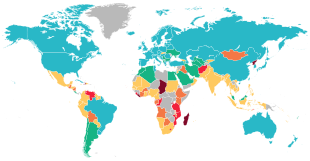Food security by country

Afghanistanedit
In Afghanistan, about 35% of households are food insecure. The prevalence of under-weight, stunting, and wasting in children under 5 years of age is also very high.
Chinaedit
The persistence of wet markets has been described as "critical for ensuring urban food security", particularly in Chinese cities. The influence of wet markets on urban food security include food pricing and physical accessibility.
Calling food waste “shameful”, Xi Jinping stressed that there should be a sense of crisis about food security. In 2020, China witnessed a rise in food prices, due to the COVID-19 outbreak and mass flooding that wiped out the country's crops, which made food security a priority for Xi Jinping, then General Secretary of the Chinese Communist Party.
Mexicoedit
Food insecurity has been an issue for Mexico throughout its history. Although food availability is not the issue, severe deficiencies in the accessibility of food contributes to the insecurity. Between 2003 and 2005, the total Mexican food supply was well above the sufficient to meet the requirements of the Mexican population, averaging 3,270 kilocalories per daily capita, higher than the minimum requirements of 1,850 kilocalories per daily capita. However, at least 10 percent of the population in every Mexican state suffers from inadequate food access. In nine states, 25–35 percent live in food-insecure households. More than 10 percent of the populations of seven Mexican states fall into the category of Serious Food Insecurity.
The issue of food inaccessibility is magnified by chronic child malnutrition, as well as obesity in children, adolescents, and family.
Mexico is vulnerable to drought, which can further cripple agriculture.
Singaporeedit
In 2019, Singapore managed to produce only 13% of leafy vegetables, 24% of its eggs, and 9% of its fish. In 1965, it was still able to produce 60% of its vegetable demand, 80% of its poultry and 100% of its eggs. In 2019, it announced it launched the "30 by 30" program which aims to drastically reduce its food insecurity through hydroponic farms and aquaculture farms.
United Statesedit
The Agriculture Department defines food insecurity as "limited or uncertain availability of nutritionally adequate and safe foods or limited or uncertain ability to acquire acceptable foods in socially acceptable ways." Food security is defined by the USDA as "access by all people at all times to enough food for an active, healthy life."
National Food Security Surveys are the main survey tool used by the USDA to measure food security in the United States. Based on respondents' answers to survey questions, the household can be placed on a continuum of food security defined by the USDA. This continuum has four categories: high food security, marginal food security, low food security, and very low food security. The continuum of food security ranges from households that consistently have access to nutritious food to households where at least one or more members routinely go without food due to economic reasons. Economic Research Service report number 155 (ERS-155) estimates that 14.5 percent (17.6 million) of US households were food insecure at some point in 2012.
Across 2016, 2017 and 2018:
- 11.1 percent (14.3 million) of U.S. households were food insecure at some time during 2018.
- In 6.8 percent of households with children, only adults were food insecure in 2018.
- Both children and adults were food insecure in 7.1 percent of households with children (2.7 million households) in 2018.
- 11.8 percent (15.0 million) of U.S. households were food insecure at some time during 2017.
- 7.4 percent (9.4 million) of U.S. households had low food security in 2016.
- 4.9 percent (6.1 million) of U.S. households had very low food security at some time during 2016.
- Both children and adults were food insecure in 8.0 percent of households with children (3.1 million households).
Democratic Republic of Congoedit
The Democratic Republic of Congo is the second-largest country in Africa and is dealing with food insecurity. Although they have an abundance of natural resources, they lack accessibility of essential foods, which makes it difficult for the Congolese people in their daily lives. Malnutrition is high among children, which affects their ability, and children who live in a rural area are affected more than children who live in an urban area. In the Democratic Republic of Congo, about 33% of households are food insecure; it is 60% in eastern provinces. A study showed the correlation of food insecurity negatively affecting at-risk HIV adults in the Democratic Republic of Congo.
In 2007–2008, grain prices increased and the people in the Democratic Republic of the Congo went to civil unrest. There were riots and protests. Hunger is frequent in the country, but sometimes it is to the extreme that many families cannot afford to eat every day. Bushmeat trade was used to measure the trend of food security. The trend signifies the amount of consumption in urban and rural areas. Urban areas mainly consume bushmeat because they cannot afford other types of meat.
Feed the Futureedit
In 2010, the government of the United States began the Feed the Future Initiative. The initiative is expected to work on the basis of country-led priorities that call for consistent support by the governments, donor organizations, the private sector, and the civil society to accomplish its long-term goals.
Comments
Post a Comment